Basic Policy
Our company has established the Management Principles of "Contributing to International Society and Continuously Increasing Our Contribution," and conducts corporate activities aimed at realizing this principle.
In formulating our management strategy, this principle serves as the most important basis for decision-making.
Guided by this unchanging Management Principle, we aim to steadily develop and grow as an indispensable company for society, without being distracted by short-term profits.
By focusing exclusively on the small DC motor business and concentrating all management resources, we have secured the world's No.1 market share in the industry.
Our ability to provide high-quality products at reasonable prices with a stable supply is thanks to our "standardization strategy" and "Mabuchi Global Management."
Currently, building on these strengths, we aim to evolve into a company that provides "movement" solutions, centered on small DC motors.
Standardization Strategy
The following are descriptions of a historical background that has made us decide to start our standardization strategy:
Background of developing the strategy
In the toy industry, which was our core market at the time of our foundation, we used to perform make-to-order production meeting individual requests that varied depending on customers. Since motors had individual specifications, we were forced to perform high-mix low-volume production (limited production of diversified products) that resulted in high production cost.
Moreover, since most of the motors for toys produced at that time were incorporated in products for Christmas sales battles in Europe and the U.S., the production volume had extreme seasonal variations, and this made it difficult to secure employment and quality that were stable all the year around.
Since these problems became overt as the motor production volume rapidly increased, we were required to stop dealing with the make-to-order production, which was the root cause of these problems, and to moderate the seasonal variations.
Standardization of products
In order to solve the above problems, we have decided to manufacture standard motors, which cover as much similarities among various needs of our customers as possible, by summing up such needs. Narrowing down the models of our motors has allowed us to perform mass production and to equalize the production. This has stabilized both employment and quality, and has widely reduced cost compared with the cost required during the time when we had been dealing with the make-to-order production. Consequently, we could reduce our motor prices dramatically.
The reduction of motor cost has also contributed to expand our motor applications as a result of sustaining and expanding our price competitiveness in relevant markets and further upgrading our motor performance continuously. Thus, a virtuous cycle has been created, in which increase in customers to purchase our standard products allows further cost reduction due to economic effects of scale, and this has led to our success in maintaining sustained competitive superiority.

Standardization of production equipment, process, and administrative task
Standardization of products has also allowed standardization of production equipment and process that create the products.
To manufacture high-quality products utilizing many employees, it is essential to thoroughly provide operating instructions to the employees. Standardization of the equipment and process has allowed efficiently educating and training the employees and then speedily putting them to the process.
Our system, which is based on "standardization" and can produce stable-quality products without necessitating highly-skilled workers, has played a leading role in increasing the number of our overseas production bases.
In addition to this, standardization of administrative task has allowed scheduled production based on control by our Head Office. This has minimized impacts of seasonal variations or economic fluctuations by industry and has ensured stable supply of mass-produced products to relevant markets.
Additionally, based on our concept of expanding the versatility of products by maximally enhancing motor functions, we are making efforts not to lightly manufacture exclusive-use motors for particular applications. Therefore, currently we only have approximately 90 basic models.
Regardless of how thought-out a standard product may be, however, there is no certainty that the product remains effective in the future without upgrading the product. It is required to always understand market needs and to reflect the needs in the performance of the standard product. Customers require not a standard product but a low-price and high-quality motor meeting their needs. The major point of "the standardization strategy" is how to attract customers' demand to our standard products through maintaining cost competitiveness and finding out market needs.
Mabuchi Global Management
Our company established its first overseas production base in Hong Kong in 1964, marking the 10th anniversary of our founding. Since then, we have continuously renewed our global production system in response to economic growth in various countries and regions, as well as changes in the portfolio of our application businesses.
Currently, under the "Five-Region Management Structure," which includes Japan, China, Asia Pacific, the Americas, and Europe, we promote local production for local consumption in each region and enhance the autonomy and independence of each base. At the same time, we leverage the connections among personnel across bases and harness the strength of diversity stemming from varied values to drive our global management.
By capitalizing on the strengths of each base, we have built a robust development, procurement, production, and sales system, enabling us to supply high-quality products globally with stability and at reasonable prices.
Recent Initiatives
For the latest initiatives regarding the standardization strategy and Mabuchi’s global management, please refer to this section as well.